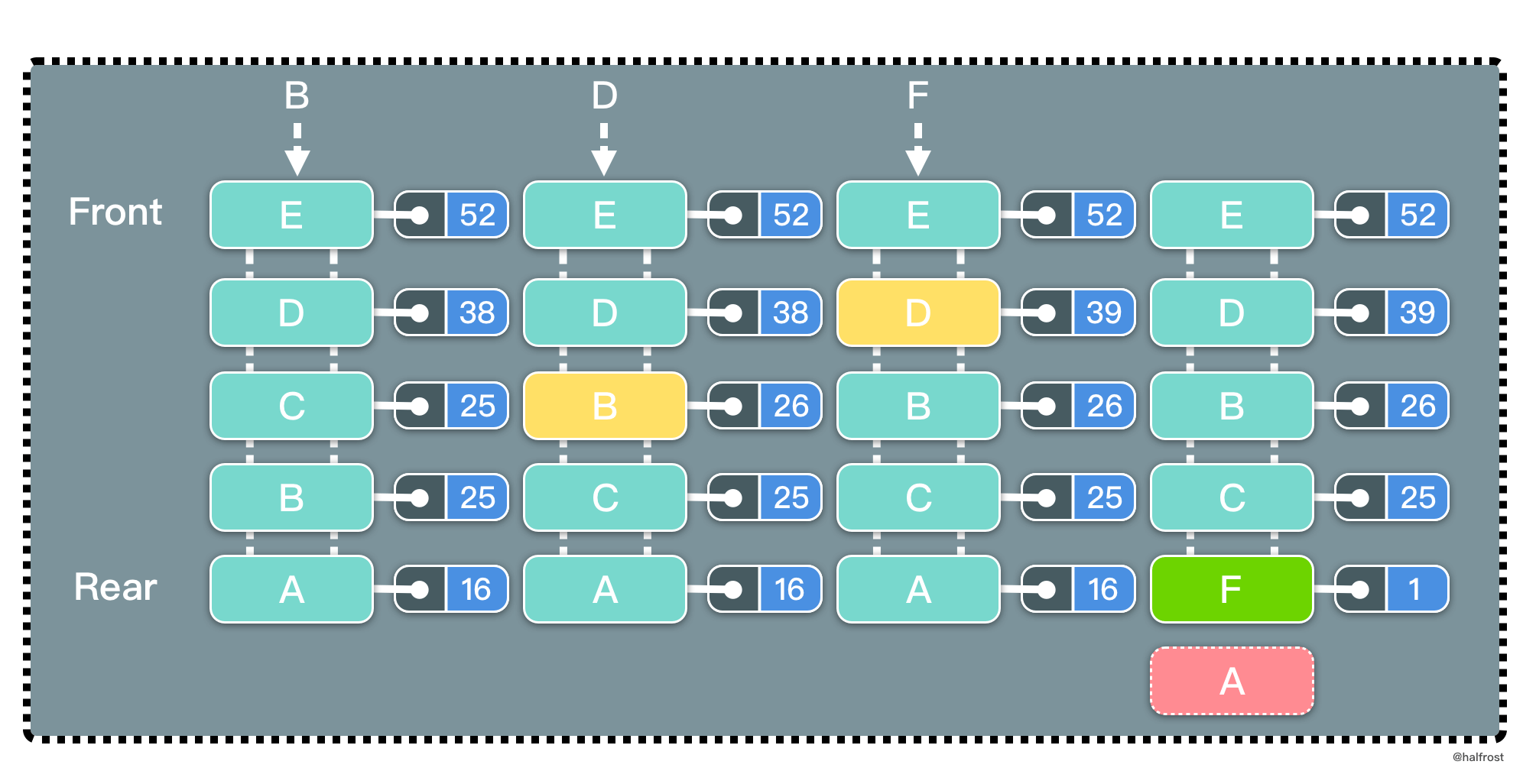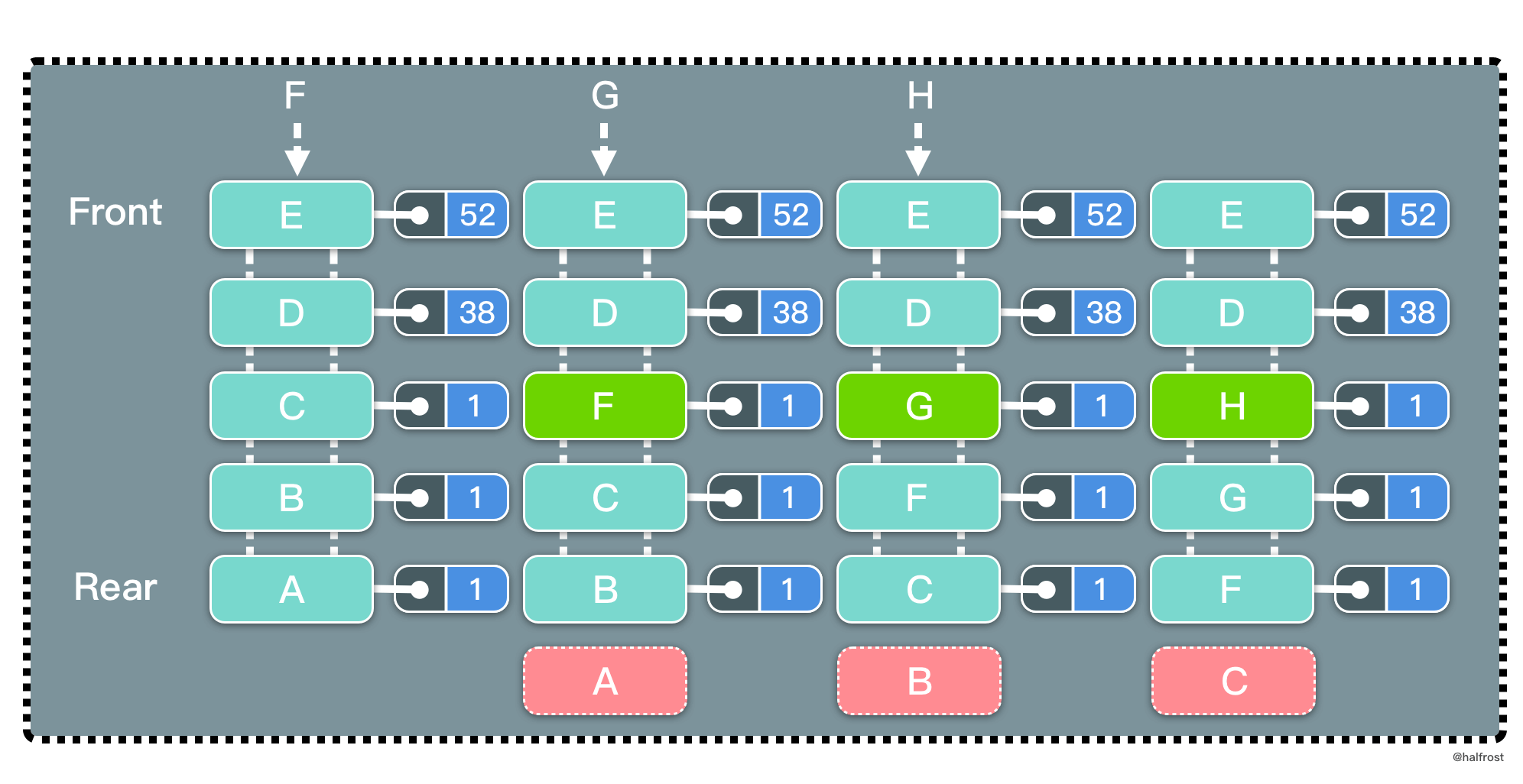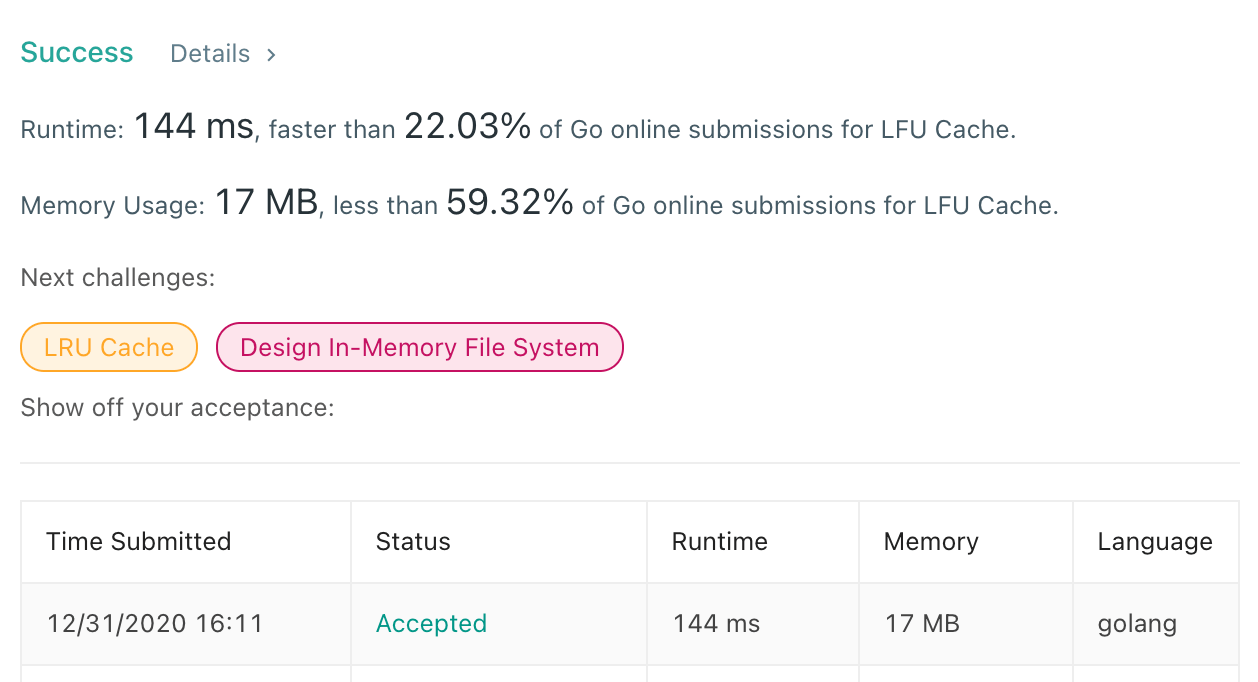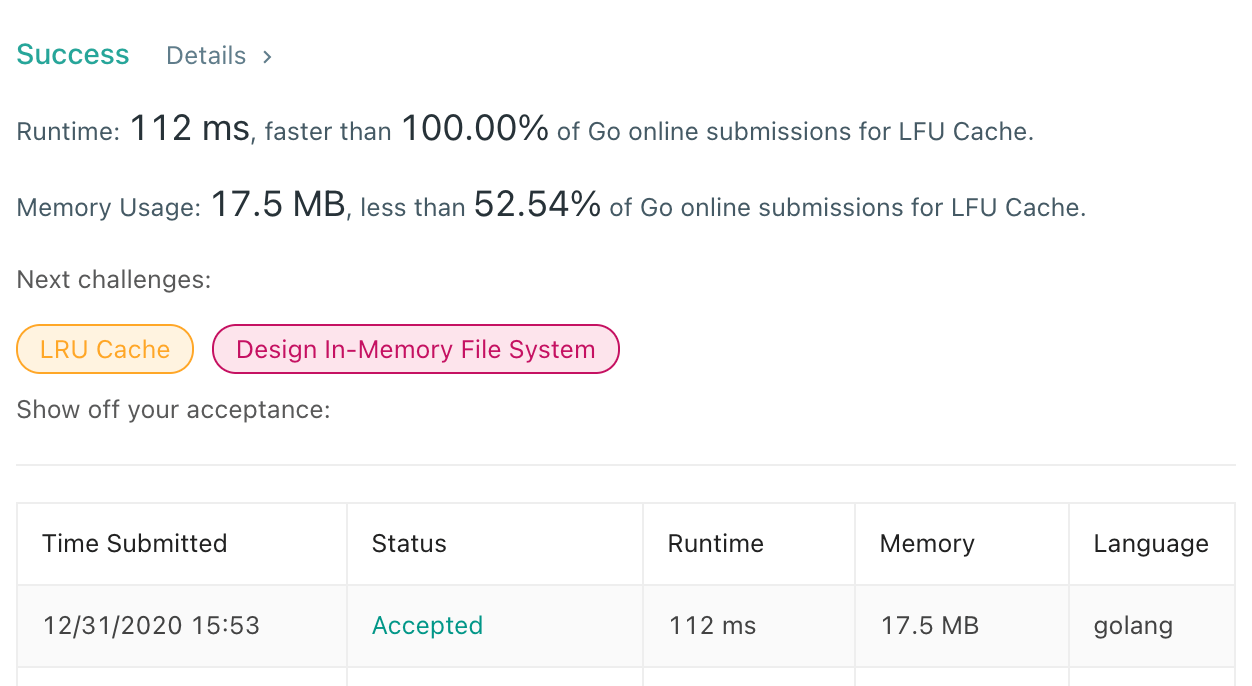最不经常最少使用 LFUCache #

LFU 是 Least Frequently Used 的缩写,即最不经常最少使用,也是一种常用的页面置换算法,选择访问计数器最小的页面予以淘汰。如下图,缓存中每个页面带一个访问计数器。

根据 LFU 的策略,每访问一次都要更新访问计数器。当插入 B 的时候,发现缓存中有 B,所以增加访问计数器的计数,并把 B 移动到访问计数器从大到小排序的地方。再插入 D,同理先更新计数器,再移动到它排序以后的位置。当插入 F 的时候,缓存中不存在 F,所以淘汰计数器最小的页面的页面,所以淘汰 A 页面。此时 F 排在最下面,计数为 1。

这里有一个比 LRU 特别的地方。如果淘汰的页面访问次数有多个相同的访问次数,选择最靠尾部的。如上图中,A、B、C 三者的访问次数相同,都是 1 次。要插入 F,F 不在缓存中,此时要淘汰 A 页面。F 是新插入的页面,访问次数为 1,排在 C 的前面。也就是说相同的访问次数,按照新旧顺序排列,淘汰掉最旧的页面。这一点是和 LRU 最大的不同的地方。
可以发现,LFU 更新和插入新页面可以发生在链表中任意位置,删除页面都发生在表尾。
解法一 Get O(1) / Put O(1) #
LFU 同样要求查询尽量高效,O(1) 内查询。依旧选用 map 查询。修改和删除也需要 O(1) 完成,依旧选用双向链表,继续复用 container 包中的 list 数据结构。LFU 需要记录访问次数,所以每个结点除了存储 key,value,需要再多存储 frequency 访问次数。
还有 1 个问题需要考虑,一个是如何按频次排序?相同频次,按照先后顺序排序。如果你开始考虑排序算法的话,思考方向就偏离最佳答案了。排序至少 O(nlogn)。重新回看 LFU 的工作原理,会发现它只关心最小频次。其他频次之间的顺序并不关心。所以不需要排序。用一个 min 变量保存最小频次,淘汰时读取这个最小值能找到要删除的结点。相同频次按照先后顺序排列,这个需求还是用双向链表实现,双向链表插入的顺序体现了结点的先后顺序。相同频次对应一个双向链表,可能有多个相同频次,所以可能有多个双向链表。用一个 map 维护访问频次和双向链表的对应关系。删除最小频次时,通过 min 找到最小频次,然后再这个 map 中找到这个频次对应的双向链表,在双向链表中找到最旧的那个结点删除。这就解决了 LFU 删除操作。
LFU 的更新操作和 LRU 类似,也需要用一个 map 保存 key 和双向链表结点的映射关系。这个双向链表结点中存储的是 key-value-frequency 三个元素的元组。这样通过结点中的 key 和 frequency 可以反过来删除 map 中的 key。
定义 LFUCache 的数据结构如下:
import "container/list"
type LFUCache struct {
nodes map[int]*list.Element
lists map[int]*list.List
capacity int
min int
}
type node struct {
key int
value int
frequency int
}
func Constructor(capacity int) LFUCache {
return LFUCache{nodes: make(map[int]*list.Element),
lists: make(map[int]*list.List),
capacity: capacity,
min: 0,
}
}
LFUCache 的 Get 操作涉及更新 frequency 值和 2 个 map。在 nodes map 中通过 key 获取到结点信息。在 lists 删除结点当前 frequency 结点。删完以后 frequency ++。新的 frequency 如果在 lists 中存在,添加到双向链表表首,如果不存在,需要新建一个双向链表并把当前结点加到表首。再更新双向链表结点作为 value 的 map。最后更新 min 值,判断老的 frequency 对应的双向链表中是否已经为空,如果空了,min++。
func (this *LFUCache) Get(key int) int {
value, ok := this.nodes[key]
if !ok {
return -1
}
currentNode := value.Value.(*node)
this.lists[currentNode.frequency].Remove(value)
currentNode.frequency++
if _, ok := this.lists[currentNode.frequency]; !ok {
this.lists[currentNode.frequency] = list.New()
}
newList := this.lists[currentNode.frequency]
newNode := newList.PushFront(currentNode)
this.nodes[key] = newNode
if currentNode.frequency-1 == this.min && this.lists[currentNode.frequency-1].Len() == 0 {
this.min++
}
return currentNode.value
}
LFU 的 Put 操作逻辑稍微多一点。先在 nodes map 中查询 key 是否存在,如果存在,获取这个结点,更新它的 value 值,然后手动调用一次 Get 操作,因为下面的更新逻辑和 Get 操作一致。如果 map 中不存在,接下来进行插入或者删除操作。判断 capacity 是否装满,如果装满,执行删除操作。在 min 对应的双向链表中删除表尾的结点,对应的也要删除 nodes map 中的键值。
由于新插入的页面访问次数一定为 1,所以 min 此时置为 1。新建结点,插入到 2 个 map 中。
func (this *LFUCache) Put(key int, value int) {
if this.capacity == 0 {
return
}
// 如果存在,更新访问次数
if currentValue, ok := this.nodes[key]; ok {
currentNode := currentValue.Value.(*node)
currentNode.value = value
this.Get(key)
return
}
// 如果不存在且缓存满了,需要删除
if this.capacity == len(this.nodes) {
currentList := this.lists[this.min]
backNode := currentList.Back()
delete(this.nodes, backNode.Value.(*node).key)
currentList.Remove(backNode)
}
// 新建结点,插入到 2 个 map 中
this.min = 1
currentNode := &node{
key: key,
value: value,
frequency: 1,
}
if _, ok := this.lists[1]; !ok {
this.lists[1] = list.New()
}
newList := this.lists[1]
newNode := newList.PushFront(currentNode)
this.nodes[key] = newNode
}
总结,LFU 是由两个 map 和一个 min 指针组成的数据结构。一个 map 中 key 存的是访问次数,对应的 value 是一个个的双向链表,此处双向链表的作用是在相同频次的情况下,淘汰表尾最旧的那个页面。另一个 map 中 key 对应的 value 是双向链表的结点,结点中比 LRU 多存储了一个访问次数的值,即结点中存储 key-value-frequency 的元组。此处双向链表的作用和 LRU 是类似的,可以根据 map 中的 key 更新双向链表结点中的 value 和 frequency 的值,也可以根据双向链表结点中的 key 和 frequency 反向更新 map 中的对应关系。如下图:

提交代码以后,成功通过所有测试用例。

解法二 Get O(capacity) / Put O(capacity) #
LFU 的另外一个思路是利用 Index Priority Queue 这个数据结构。别被名字吓到,Index Priority Queue = map + Priority Queue,仅此而已。
利用 Priority Queue 维护一个最小堆,堆顶是访问次数最小的元素。map 中的 value 存储的是优先队列中结点。
import "container/heap"
type LFUCache struct {
capacity int
pq PriorityQueue
hash map[int]*Item
counter int
}
func Constructor(capacity int) LFUCache {
lfu := LFUCache{
pq: PriorityQueue{},
hash: make(map[int]*Item, capacity),
capacity: capacity,
}
return lfu
}
Get 和 Put 操作要尽量的快,有 2 个问题需要解决。当访问次数相同时,如何删除掉最久的元素?当元素的访问次数发生变化时,如何快速调整堆?为了解决这 2 个问题,定义如下的数据结构:
// An Item is something we manage in a priority queue.
type Item struct {
value int // The value of the item; arbitrary.
key int
frequency int // The priority of the item in the queue.
count int // use for evicting the oldest element
// The index is needed by update and is maintained by the heap.Interface methods.
index int // The index of the item in the heap.
}
堆中的结点存储这 5 个值。count 值用来决定哪个是最老的元素,类似一个操作时间戳。index 值用来 re-heapify 调整堆的。接下来实现 PriorityQueue 的方法。
// A PriorityQueue implements heap.Interface and holds Items.
type PriorityQueue []*Item
func (pq PriorityQueue) Len() int { return len(pq) }
func (pq PriorityQueue) Less(i, j int) bool {
// We want Pop to give us the highest, not lowest, priority so we use greater than here.
if pq[i].frequency == pq[j].frequency {
return pq[i].count < pq[j].count
}
return pq[i].frequency < pq[j].frequency
}
func (pq PriorityQueue) Swap(i, j int) {
pq[i], pq[j] = pq[j], pq[i]
pq[i].index = i
pq[j].index = j
}
func (pq *PriorityQueue) Push(x interface{}) {
n := len(*pq)
item := x.(*Item)
item.index = n
*pq = append(*pq, item)
}
func (pq *PriorityQueue) Pop() interface{} {
old := *pq
n := len(old)
item := old[n-1]
old[n-1] = nil // avoid memory leak
item.index = -1 // for safety
*pq = old[0 : n-1]
return item
}
// update modifies the priority and value of an Item in the queue.
func (pq *PriorityQueue) update(item *Item, value int, frequency int, count int) {
item.value = value
item.count = count
item.frequency = frequency
heap.Fix(pq, item.index)
}
在 Less() 方法中,frequency 从小到大排序,frequency 相同的,按 count 从小到大排序。按照优先队列建堆规则,可以得到,frequency 最小的在堆顶,相同的 frequency,count 最小的越靠近堆顶。
在 Swap() 方法中,记得要更新 index 值。在 Push() 方法中,插入时队列的长度即是该元素的 index 值,此处也要记得更新 index 值。update() 方法调用 Fix() 函数。Fix() 函数比先 Remove() 再 Push() 一个新的值,花销要小。所以此处调用 Fix() 函数,这个操作的时间复杂度是 O(log n)。
这样就维护了最小 Index Priority Queue。Get 操作非常简单:
func (this *LFUCache) Get(key int) int {
if this.capacity == 0 {
return -1
}
if item, ok := this.hash[key]; ok {
this.counter++
this.pq.update(item, item.value, item.frequency+1, this.counter)
return item.value
}
return -1
}
在 hashmap 中查询 key,如果存在,counter 时间戳累加,调用 Priority Queue 的 update 方法,调整堆。
func (this *LFUCache) Put(key int, value int) {
if this.capacity == 0 {
return
}
this.counter++
// 如果存在,增加 frequency,再调整堆
if item, ok := this.hash[key]; ok {
this.pq.update(item, value, item.frequency+1, this.counter)
return
}
// 如果不存在且缓存满了,需要删除。在 hashmap 和 pq 中删除。
if len(this.pq) == this.capacity {
item := heap.Pop(&this.pq).(*Item)
delete(this.hash, item.key)
}
// 新建结点,在 hashmap 和 pq 中添加。
item := &Item{
value: value,
key: key,
count: this.counter,
}
heap.Push(&this.pq, item)
this.hash[key] = item
}
用最小堆实现的 LFU,Put 时间复杂度是 O(capacity),Get 时间复杂度是 O(capacity),不及 2 个 map 实现的版本。巧的是最小堆的版本居然打败了 100%。

模板 #
import "container/list"
type LFUCache struct {
nodes map[int]*list.Element
lists map[int]*list.List
capacity int
min int
}
type node struct {
key int
value int
frequency int
}
func Constructor(capacity int) LFUCache {
return LFUCache{nodes: make(map[int]*list.Element),
lists: make(map[int]*list.List),
capacity: capacity,
min: 0,
}
}
func (this *LFUCache) Get(key int) int {
value, ok := this.nodes[key]
if !ok {
return -1
}
currentNode := value.Value.(*node)
this.lists[currentNode.frequency].Remove(value)
currentNode.frequency++
if _, ok := this.lists[currentNode.frequency]; !ok {
this.lists[currentNode.frequency] = list.New()
}
newList := this.lists[currentNode.frequency]
newNode := newList.PushBack(currentNode)
this.nodes[key] = newNode
if currentNode.frequency-1 == this.min && this.lists[currentNode.frequency-1].Len() == 0 {
this.min++
}
return currentNode.value
}
func (this *LFUCache) Put(key int, value int) {
if this.capacity == 0 {
return
}
if currentValue, ok := this.nodes[key]; ok {
currentNode := currentValue.Value.(*node)
currentNode.value = value
this.Get(key)
return
}
if this.capacity == len(this.nodes) {
currentList := this.lists[this.min]
frontNode := currentList.Front()
delete(this.nodes, frontNode.Value.(*node).key)
currentList.Remove(frontNode)
}
this.min = 1
currentNode := &node{
key: key,
value: value,
frequency: 1,
}
if _, ok := this.lists[1]; !ok {
this.lists[1] = list.New()
}
newList := this.lists[1]
newNode := newList.PushBack(currentNode)
this.nodes[key] = newNode
}